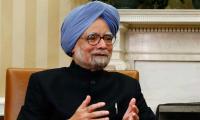The global economy is facing a plunge into uncharted waters. No one alive has experienced an economic nosedive this sudden. In country after country, as a result of lockdowns and disruptions, large swaths of economic activity has halted – almost frozen in place.
One reason things have gotten so bad so quickly is that economic weakness feeds on itself, with demand falling as more businesses shut their doors and layoffs spread. Smaller companies and the self employed are the hardest hit.
The dominant consensus among leading economists is that there is no quick recovery. They agree that 'V' shape recovery – a sharp drop in economic activity followed swiftly by a rebound in growth – is highly unlikely. Under the best of circumstances , which would require decisive and bold steps and a resurgence in consumer confidence, they believe that recovery will look like a 'U' shape – a long trench in the bottom before it gets to the recovery period. There is widespread consensus that if governments don’t get their act together on the medical and economic fronts, recovery could look more ‘L’ shaped – precipitous drop in economic activity, followed by years of a depression-like situation .
The OECD has warned that the world will take years to recover from the pandemic. The IMF is now saying that the coronavirus economic impact ‘will be severe,’ and maybe as bad as the Great Recession. Some economists are even saying that “this is not a recession, it is an ice age”.
Governments around the world are taking unprecedented steps to shore up health systems and support workers and businesses to cope with the impact of the outbreak. At last count , the level of global fiscal and monetary stimulus amounts to about $7 trillion, of which the US alone is considering about $3.5-4 trillion. The US fiscal stimulus could be as high as 40 percent of its annual budget. Despite this large level of stimulus, most economists believe that the stimulus would probably only blunt the pandemic’s impact, not stave it off. The coronavirus crisis is a story with an unclear ending. The consensus globally on stimulus is: Act Fast and Think Big.
The stimulus programme announced by the PM on March 24 has many good features, though it disingenuously includes annual wheat procurement and refunds as part of stimulus. Importantly, it falls short in many respects. Pakistan must throw out of the window it’s ‘business-as-usual’ rules and meek thinking. The programme comes across as ‘made by the IMF, for the IMF’. As a first step, Pakistan must ‘lockdown the IMF Programme’, which is a deeply flawed cookie cutter programme. The whole world is in crisis, and any action Pakistan does to stave off and blunt the crisis will be accepted. The following additional actions should be considered to break the downward spiral and avoid an ‘L’-shaped recovery.
First, immediately slash the lending rate to 4-5 percent, and accordingly slash the discount rate and deposit rates. The whole world is working towards a zero interest rate, and the SBP’s current interest rate policy is suicidal and dead wrong. Financial repression, hard intervention and reduced central bank independence, for a year or two, is a perfectly acceptable policy instrument, and has been used by developed and developing countries in times of crisis. Because of lack of opportunities to move deposits outside Pakistan, such a policy will not reduce liquidity. The SBP should inject whatever liquidity is necessary to ensure financial stability. Moreover, banks made profits before tax of close to Rs200 billion last year. They can easily absorb any reduction in income because of the above action. In any case, contingent funding of Rs100 billion should be set aside to ensure that banks do not have any losses.
Also, anyone holding government paper, including NSS holders, will have lower interest income. But that should not be cause for concern. Small savers could be protected, but large savers (wealthy individuals and the corporate sector) would have to accept a drop in interest income to help fight the crisis.
Second, establishing a Rs1 trillion grant-cum-zero interest long-term loan facility, to finance 4-6 months of fixed costs (rent, worker wages, utility and loan payments) of the close to three million registered manufacturing and service business, where the bulk of formal employment takes place. This financing would allow businesses to stay open until the crisis recedes.
A simple procedure should be put in place to disburse the funds. The first month’s payment could be made on the basis of simple forms submitted by the businesses to their banks, with subsequent monthly payments based on ‘light’ verification by banks on information provided by the business and requiring non-filing businesses to become tax filers. Also, micro/small businesses could get mostly grants, while large businesses mostly ‘non-collateralized’ zero interest loans to be paid off in 5-7 years.
Third, eliminate the across-the-board petroleum relief and instead give a petrol subsidy of Rs300-400 per month to all motorcycle owners for a period of 4-6 months. Since all motorcycles are registered against a CNIC, a subsidy could be provided through SIMs issued against the CNICs through schemes such as Easy Paisa, MobiCash, etc.
Fourth, a subsidized price/bare minimum items monthly ration distribution scheme, for 3-4 months, in all cities, organized at stadiums and large grounds. Rs 400-500 billion should be allocated for this. The civil/military authorities could be tasked to organize distribution, while ensuring social distancing. Using technology and the NADRA family tree data, it could be easily ensured that one family gets only one ration. Technology and higher pricing at Utility Stores would ensure that families do not double dip.
The budgetary cost of these schemes could run into an additional Rs1.5-2 trillion. All the above schemes would be backed by punitive laws to prevent abuse by business owners and by the better off in society – at least several years of jail, and refund of several multiples of subsidy.
The following actions could be considered to finance a substantial share of the stimulus and minimize the pressure on the exchange rate. First, the slashing of interest rates on government borrowings from banks, government securities and National Savings. This could save the government Rs400-500 billion of interest expense for this fiscal year. Second, having protected motorcycle owners, petroleum levies should be increased and the entire windfall from drop in oil prices should be retained by the government. Our petroleum prices are among the lowest in South Asia. The target should be to raise additional Rs 400-500 billion from the petroleum sector.
Third, imposing a hefty sin tax on palm oil and sugar. Citizens must be made aware through an aggressive campaign that consumption of these is bad for health and at this time of national crisis they need to pay a sin tax. The sin tax on sugar used by the beverage and confectionary industry must be punitive. Once again, the aim should be to raise Rs200-300 billion additional taxes.
Fourth, a fixed transaction tax of Rs 3-4 per share, whenever it is bought or sold, and capital gains tax of 50 percent on stocks. Notwithstanding the recent drop in the KSE index, over the last decade or so, the wealth created (increase in market capitalization) runs into several trillion rupees. It has all accrued to about 30,000-40,000 wealthy individuals/corporates, and very little of that has been taxed. It's time these super wealthy individuals and corporates share this wealth to fight the national crisis. The aim should be to raise at least Rs300-400 billion additional. These measures will lower the KSE index, but will not have any negative national impact.
Because of the global crisis, the world will accept if Pakistan takes extraordinary steps to overcome the economic impact of the pandemic. With that in mind, Pakistan should take the following steps to reduce pressure on the exchange rate: (i) renegotiating all take or pay contracts, to dramatically reduce debt service and profits; (ii) suspending all foreign dividend payments for at least 12 months; and (iii) suspending withdrawal of ‘hot money’ and FDI in the stock market, for at least 12 months.
The prime minister must stop listening to his under performing economic team, who are slavishly beholden to the IMF programme. The budget deficit and debt stock will balloon, but so be it. Extraordinary times require extraordinary solutions. It’s time Pakistan needs to throw everything it has, to avoid an L-shaped economic meltdown.
The writer is a former adviser to the World Bank.
MPAs ask for their salaries and benefits to be at par with high court judges and exempt from tax
This system fosters and places premium on VIPs, facilitating VIP culture, which is alive and kicking
Imagine this waste covering over 15,500 cricket stadiums, piled three meters deep every year
If there is one thing that can be gleaned from politics today, it is that we no longer speak same language
Postman argues that “typographic mind” was yielding to “televisual mind”
Pakistan is well poised to meet opportunities that Artificial Intelligence will offer for developments in industries







